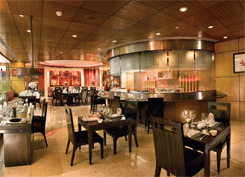 MBD Radisson Blu's Rare Eastern Dining is a hotpot of contemporary flavours from China, Japan, Malaysia, Singapore and Thailand, says VIDYA DESHPANDE
MBD Radisson Blu's Rare Eastern Dining is a hotpot of contemporary flavours from China, Japan, Malaysia, Singapore and Thailand, says VIDYA DESHPANDE
The most popular cuisine in India, after desi food, has to be Chinese: from the greasy “chowmien” offered by food trucks to the Punjabi- Chinese variety of “chilly paneer” and “gobi manchurian”, to the more subtly flavoured genuine dishes available at up-market restaurants. Yes, Chinese cuisine has a large fan following in India, but not surprisingly Thai, Malaysian, Japanese and Korean flavours, too, are finding their way into restaurant menus. And with the local taste buds accepting more international palates, you can actually get food that is more realistic and closer to the original, than just Indianised versions.
And that’s exactly what R.E.D, the pan-Asian restaurant at the Radisson Blu in Noida, has done. It has an eclectic mix of eastern cuisines to cater to Indian tastes, but thankfully without the chilly paneers or the gobi manchurians on its menu. “Although these items are not on our menu, I never say ‘No’ if a customer asks for these dishes,’ Says Chef Raymond Sim, who is the master behind this restaurant since its inception in 2003. The menu is replete with alternate options; for instance, the stir-fried vegetables are a simple, yet tasty combination of Chinese greens tossed in a wok, with their umami flavours standing out. “Most authentic Chinese dishes have subtle flavours that don’t suit Indian tastes,” says Sim. “I have to step up the salt and chilly flavours to make them more suitable for my clients,” he admits.
To sample what he was referring to, Sim whipped up a deep-fried lotus stem tossed with black pepper and flavourings. The dish was simple, yet tasty and the crispiness of the lotus stem gave it a crunch. “This dish works well as an appetiser as well as part of the main course,” says Sim. Another dish that he served was wok-tossed greens such as broccoli, asparagus and pak choy, Ching Chao Ri Shuchi. Simple, with no-fuss flavours that appeal to all taste buds.
R.E.D specialises in an array of unusual appetisers. I sampled some sushi that is on the menu. The Dynamite Roll, with prawn tempura, wasabi mayonnaise in a tobiko reverse roll, is a house specialty. The tempura prawn gives the roll its crispiness, while the wasabi mayonnaise gives it a sharp tanginess. The other one I sampled was the Sushi Tempura Roll, a fried sushi roll made tempura style, with salmon and tuna: simple, yet delicious. At Chef Sim’s insistence, I also sampled some of the dumplings: the Chicken Hot Pot Sticker and Prawn Sui Mai. Both light on the palate, and his special in-house Nonya-style chili sauce, which took the taste buds to another level.
But the crowning glory of the appetisers I sampled was chef’s special creation: espresso spare ribs. “I get the coffee from Singapore, as I want a certain kind of flavour to the dish that I can’t get with local coffee beans,” he says. The caramelised ribs are prominently sweet with the nutty aroma of coffee, making it a dish with a twist. Another popular dish in the exhaustive appetizer section is the Kung Thord Krathiyam, crispy fried prawns, wok tossed with crushed black pepper and garlic, finished with fried shallots. The dish is Thai in origin and is suited to Indian likes.
After the wide sampling of appetisers, Chef Sim sent some clear chicken soup of the table to clear my palate before the main course. The main course was kept simple — an egg fried rice with steamed fish, Nonya Style, and stirfried prawns in a Indo-Malay chilisambal sauce. Chef Sim is reluctant to do his home country’s famous Chilli Crab, although it’s there on the menu; he does not dish it up often since he is not happy with the quality of crabs available in Delhi. “Although crabs are available in the market, I mostly don’t find them up to the mark. Many times, the claws have more water than flesh, leaving clients disappointed,” he says. So on a day he gets good quality catch, that’s when he would recommend trying the Singaporean Chilli Crab. Chef Sim also does not do the famous seafood hotpot available in most Oriental restaurants. He ascribes the same reasons of poor quality seafood in the city that take away for the quality of a good hotpot.
Chef Sim likes to cook in Nonya style, which is a blend of Chinese ingredients with spices from Malaysia and Indonesia, and is popular in Singapore. Nonya ingredients include galangal, shallots, kafir lime, coconut milk, tamarind juice, lemongrass and shrimp-based condiments, among others.
And finally to finish the meal, a simple litchi ice cream with fresh cut Alphonso mangoes, made for dessert. It was refreshing, especially considering the outside temperature was at its peak of 42 deg C, while I was lunching at R.E.D.
What makes the dining experience special at R.E.D is Chef Sim interacts with most of the tables; he finds out what his customers would like to eat, and goes out of the way to cook even if it’s not there on the menu. The restaurant also offers diners the option of using the induction tables to cook for their guests or you can pick your ingredients and catch and watch the chefs in action in their show kitchen. Overall, on a scale of 1 to 10, I would rate the meal at R.E.D at 8.5.
